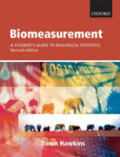
Statistical analysis allows us to attach meaning to data which we have collected; it helps us to understand what results really mean, and to assess whetherwe can trust what experiments seem to be telling us. Yet, despite being a collection of the most valuable and important tools available to bioscientists, statistics is the aspect of study which most students fear more than any other.Biomeasurement offers a refreshing, student-focused introduction to the use of statistics in the study of the biosciences. With an emphasis on why statistical techniques are essential tools for bioscientists, the book removes the stigma attached to statistics by giving students the confidence to use and further explore the key techniques for themselves. The book starts by placing the role of data analysis in the context of wider scientific method, and introduces the student to the key terms and concepts which are common to all statistical tools. It then guides the student through descriptive statistics, and on to inferential statistics, explaining how and why each type of technique is used, and what each can tell us in order to better understand our data. The book goeson to present the key statistical tests, walking the student step-wise through the use of each, with carefully integrated examples, and plentiful opportunities for hands-on practice. The book closes with an overview of choosing the right test to suit your data, and tools for presenting data and their statistical analyses. Written by a talented educator, whose teaching has won praise from the UK's Quality and Assurance Agency for Higher Education, Biomeasurement is sure to engage even the most wary of students, demonstrating the power and importance of statistics throughout the study of bioscience. INDICE: CHAPTER 1: WHY AM I READING THIS BOOK?; 1.1 My lecturer is a sadist!; 1.2 Doing science: the big picture; 1.3 The process in practice; 1.4 Essential skills for doing science; 1.5 Types of data analysis; CHAPTER 2: GETTING TO GRIPS WITH THE BASICS; 2.1 Populations and samples; 2.2 Variation and variables; 2.3 Understanding data; 2.4 Demystifying formulae; CHAPTER 3: DESCRIBINGA SINGLE SAMPLE; 3.1 The single sample; 3.2 Descriptive statistics; 3.3 Frequency distributions; 3.4 Pies, boxes, and errors; 3.5 Example data: ranger patrol tusk records; 3.6 Worked example: using SPSS; CHAPTER 4: INFERRING AND ESTIMATING; 4.1 Overview of inferential statistics; 4.2 Inferring through estimation; 4.3 Exampledata: ground squirrels; 4.4 Worked example: using SPSS; CHAPTER5: OVERVIEW OF HYPOTHESIS TESTING; 5.1 Four steps of (statistical) hypothesistesting; 5.2 Error and power; 5.3 Parametric and nonparametric; 5.4 One-and two-tailed tests; CHAPTER 6: TESTS ON FREQUENCIES; 6.1 Introduction to chi-square tests; 6.2 Example data; 6.3 One-way classification chi-square test; 6.4 Two-way classification chi-square test; CHAPTER 7: TESTS OF DIFFERENCE: TWO UNRELATED SAMPLES; 7.1 Introduction to the t-and Mann-Whitney U tests; 7.2 Exampledata: dem bones; 7.3 t-Test; 7.4 Mann-Whitney U test; CHAPTER 8: TESTS OF DIFFERENCE: TWO RELATED SAMPLES; 8.1 Introduction to paired t- and Wilcoxon signed- rank tests; 8.2 Example data: big horn ewes; 8.3 Paired t-test; 8.4 Wilcoxon signed-rank test; CHAPTER 9: TESTS OF DIFFERENCE: MORE THAN TWO SAMPLES; 9.1Introduction to one-way and Kruskal-Wallis Anov atests; 9.2 Example data: nitrogen levels in reeds; 9.3 One-way Anova test; 9.4 Two-way Anova test; 9.5 Kruskal-Wallis test; 9.6 Model I and model II Anova; CHAPTER 10: TESTS OF RELATIONSHIP: REGRESSION; 10.1 Introduction; 10.2 Example data: species richness; 10.3 Regression test; 10.4 Logistic regression; 10.5 Multiple regression; 10.6 Model I and model II regression; CHAPTER 11: TESTS OF RELATIONSHIP: CORRELATION;11.1 Introduction to the Pearson and Spearman correlation tests; 11.2 Exampledata: eyeballs; 11.3 Pearson correlation test; 11.4 Spearman correlation test; 11.5 Comparison of correlation and regression; CHAPTER 12: INTRODUCING TH GENERAL LINEAR MODEL; 12.1 Introduction to General Linear Model; 12.2 Example data: watered willow; 12.3 Testing using the General Linear Model; 12.4 Interaction; 12.5 Random factors and mixed models; 12.6 Types of sums of squares; 12.7Getting the most out of GLM: Multiple models and model choice; 12.8 The general and generalized linear models compared; CHAPTER 13: CHOOSING THE RIGHT TESTAND GRAPH; 13.1 Introduction to choosing; 13.2 Which test?; 13.3 Which graph?; 13.4 Worked examples: graphs using SPSS; 13.5 How to report your results
- ISBN: 978-0-19-921999-5
- Editorial: Oxford University
- Encuadernacion: Rústica
- Páginas: 360
- Fecha Publicación: 01/03/2009
- Nº Volúmenes: 1
- Idioma: Inglés
